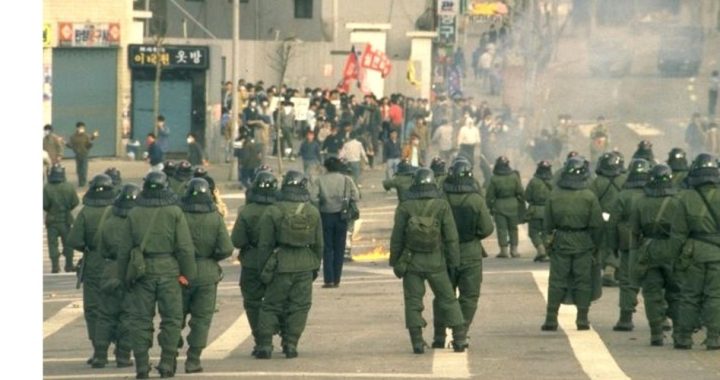
“Defense Support of Civil Authorities,” a Defense Department Directive issued on December 29, 2010, outlines the conditions under which federal military forces could be used to put down civil unrest. However, the directive states that such forces “shall not be used to quell civil disturbances unless specifically authorized by the president in accordance with applicable law or permitted under emergency authority.”
The directive, which was signed by then-Deputy Secretary of Defense William J Lynn III, has remained in force largely unnoticed until the Washington Times ran an exposé on it on May 28.
Officially known as DOD Directive No. 3025.18, the document provides carte blanche “temporary” authority to federal commanders even in some “extraordinary” cases where prior presidential authority has not been obtained.
“In these circumstances, those federal military commanders have the authority, in extraordinary emergency circumstances where prior authorization by the president is impossible and duly constituted local authorities are unable to control the situation, to engage temporarily in activities that are necessary to quell large-scale, unexpected civil disturbances” notes 3025.18, under two conditions:
&bill; Such activities are necessary to prevent significant loss of life or wanton destruction of property and are necessary to restore governmental function and public order; or,
&bill; When duly constituted Federal, State, or local authorities are unable or decline to provide adequate protection for Federal property or Federal governmental functions. Federal action, including the use of Federal military forces, is authorized when necessary to protect the Federal property or functions.
The Times quoted an unnamed defense official who said: “This appears to be the latest step in the administration’s decision to use force within the United States against its citizens.”
The directive also addressed unmanned aircraft, or “drones”: “No DoD unmanned aircraft systems (UAS) will be used for DSCA [Defense Security Cooperation Agency] operations, including support to Federal, State, local, and tribal government organizations, unless expressly approved by the Secretary of Defense. Use of armed UAS for DSCA operations is not authorized.”
If the Defense Department is adhering to the above regulation (which many will doubt) then it is operating under more restrictions than other federal agencies. As Thomas Eddlem noted in his May 9, 2012 article, “Drones Over America,” “The Customs and Border Protection Agency (CBP) currently operates seven Predator B drones, and hopes to expand that number to 24 by 2016. The Los Angeles Times reported in December 2011 that CBP has been making its Predator drones available for domestic law enforcement operations by local police departments.”
In our January 15 article, “Customs and Border Protection Loaning Drones to Police,” we noted:
U.S. Customs and Border Protection (CBP) — the law-enforcement agency created as a division of the Department of Homeland Security in 2003 — flew nearly 700 surveillance missions on behalf of other federal, as well as state and local, law-enforcement agencies from 2010 to 2012. These figures came from flight logs released recently in response to a Freedom of Information Act (FOIA) lawsuit filed by the Electronic Frontier Foundation (EFF), a civil-liberties group….
Among the federal, state, and local law-enforcement agencies “borrowing” CBP’s drones were the FBI, ICE, the U.S. Marshals, the Coast Guard, the Minnesota Bureau of Criminal Investigation, the North Dakota Bureau of Criminal Investigation, the North Dakota Army National Guard, and the Texas Department of Public Safety.
In an October 13, 2013 article, “Border Patrol Loaning Predator Drones to Military, State, and Local Police,” Joe Wolverton wrote:
CBP Predators have been used to conduct missions for the following federal and state government agencies: U.S. Secret Service, Federal Emergency Management Agency (FEMA), Immigration and Customs Enforcement (ICE); Bureau of Land Management; Federal Bureau of Investigation; Department of Defense; Texas Rangers; U.S. Forest Service; and National Oceanic and Atmospheric Administration (NOAA). [Emphasis added.]
Which brings up an interesting question: Since DOD Directive No. 3025.18 states that “No DoD unmanned aircraft systems” (drones) can be used for DOD operations “unless expressly approved by the Secretary of Defense,” and CBP has loaned Predator drones to the DOD, has the Secretary of Defense approved their use?
Apparently, members of Congress wanted to know the answer to this question in March 2013 when they included language in the 2013 House appropriations bill requiring the Defense Secretary to submit a report to Congress explaining what policies and procedures are in place for the military to ensure that the constitutional rights of Americans are not violated by any Pentagon drones flown within the United States.
When we tracked the progress of that appropriations bill (H.R. 933) as a version of it was passed by the Senate and signed into law (it became Public Law No: 113-6) we found that the language pertaining to drones had been watered down considerably:
Sec. 8083. (a) None of the funds appropriated by this Act may be used to transfer research and development, acquisition, or other program authority relating to current tactical unmanned aerial vehicles (TUAVs) from the Army.
(b) The Army shall retain responsibility for and operational control of the MQ-1C Gray Eagle Unmanned Aerial Vehicle (UAV) in order to support the Secretary of Defense in matters relating to the employment of unmanned aerial vehicles.
From that language, it appears that it is alright for the Department of Defense to employ drones, so long as the Army is given control of them.
However, the Defense Department is not the only federal department troubling Americans who are concerned that we are evolving into a federal police state. A report from Fox News last September about a raid on the Alaska gold mining town of Chicken, Alaska — by what Fox described as “over armed EPA agents” — raised concerns about the 40 federal agencies that have armed divisions. The report noted that nearly a dozen of these agencies are not usually associated with law enforcement. Fox News reported:
The Fish and Wildlife Service, Bureau of Land Management and Park Service are among 24 federal agencies employing more than 250 full-time armed officers with arrest authority, according the federal report, which is based on the 2008 Census of Federal Law Enforcement Officers.
The other 16 agencies have less than 250 officers and include NOAA as well as the Library of Congress, the Federal Reserve Board and the National Institutes of Health.
The number of federal departments with armed personnel climbs to 73 when adding in the 33 offices of inspector general, the government watchdogs for agencies as large as the Postal Service to the Government Printing Office, whose IG has only five full-time officers.
While the wording of DOD Directive No. 3025.18 attempts to reassure the public by stating that “Federal military forces shall not be used to quell civil disturbances unless specifically authorized by the president in accordance with applicable law or permitted under emergency authority,” when a government wants to consolidate power, it can define almost anything as an “emergency.”
Photo of Tiananmen Square, China during the student protests
Related articles:
Sheriff Uses Air Force Drone to Track Suspects
U.S. Army Brigade On Call for Domestic Emergencies
20,000 Troops To Be Deployed in United States
Obama Signs National Defense Authorization Act into Law
Battling Terrorism With Tyranny
Secret Military Training Blurs Line Between Police and Soldiers



